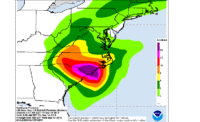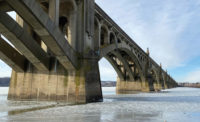Elevating structures, buying out businesses and homeowners, improving levees and building new detentions and embankments are some of the best ways to protect vulnerable towns like Lumberton and Princeville along the Lumber River in North Carolina. That’s the conclusion reached by a study released in May examining ways to help prevent future damage of the kind the area received following 2016’s Hurricane Matthew and other major storms.
Buyouts had barely begun before Hurricane Florence hit on Sept. 14, bringing more than 30 in. of rain in many places in North Carolina, exceeding the previous records set just two years ago and causing multiple rivers to flood. As of Sept. 25, there was major flooding in Lumberton and Fair Bluff, and waters were rising near Wilmington as they moved toward the Atlantic.
Efforts are still focused on recovery and emergency repairs in the Carolinas, including on damaged roads, breached coal ash and cooling ponds, flooded pig and chicken farms and the Military Ocean Terminal Sunny Point, one of the largest military terminals in the world. At the terminal, a dam collapsed and several roads failed during the storm. North Carolina was still advising motorists not to drive in 10 counties because of flooded and washed-out roads as of Sept. 25. Storm-related damages will total between $38 billion and $50 billion, according to Moody’s Analytics.
Waters have receded in some places, allowing repair of damaged infrastructure. “The severity of the flooding still occurring is limiting access for equipment to reach all areas,” says Barry Jenkins, director of AGC Carolinas’ highway-heavy construction division. Until inspections can be performed, he adds, the full extent of the damage cannot be determined. Duke Energy, likewise, couldn’t reach the edge of an overtopped cooling pond around Sutton Lake, on the Cape Fear River, to make repairs.
Other assessments hadn’t yet been completed. “There are parts of our system that we still haven’t seen, they’ve been flooded,” Jim Flechtner, executive director of the Cape Fear Public Utility Authority said Sept. 25.
N.C. Dept. of Transportation inspectors identified voids beneath bridge approaches at the Lumber and Cape Fear rivers that then were filled with polyurethane grout by on-call contractors Applied Polymetrics, Mt. Airy, N.C., and Hayward Baker,
Balfour Beatty’s Wilmington office is among the contractors assisting NCDOT with repairs to Interstate 40 and other roads, filling in washouts and conducting emergency work as directed by the agency. “It is likely the team will also assist in conducting permanent, long-term repairs” to I-40, which reopened in North Carolina Sept. 24, says Balfour Beatty spokesperson Matt Averitt.
Across the border in South Carolina, several rivers in the state’s northeastern counties were still rising. In response, S.C. Department of Transportation scrambled to erect flood barriers to keep several of the region’s key access routes open as long as possible.
Still Preparing for Floods
In Horry County, A.O. Hardee & Sons, Little River, S.C., worked with SCDOT crews and National Guard units to construct a 1.5-mile barrier of concrete, poly-plastic sheeting and one-ton sandbags on the approaches and deck of the U.S. 501 bridge, the primary land connection to communities around Myrtle Beach. Without the barrier, the Waccamaw River could overtop the roadway by as much as two feet, SCDOT said.
Downriver, two water-filled segmented cofferdam systems totaling 5,500 ft were deployed at bridges along U.S. Route 17 and U.S. Route 521, preserving limited access to coastal communities. With the Waccamaw River expected to reach flood crest by about Sept. 28 and remain at that level for up to three days, SCDOT chief Christy Hall told reporters that closure of the corridors was inevitable. The bridges were also being closely monitored for scour or other damage.
“This is an unprecedented event for South Carolina, especially for this region,” Hall said. She added that the agency might resort to using barges and aircraft for cross-river material transport as an emergency measure.
Electricity has been restored in South Carolina and is nearing complete restoration in North Carolina, but the electric utilities were having other problems, including overtopping of coal ash ponds. The Waterkeeper Alliance criticized Duke’s lack of preventative action to clean up its coal ash ponds in North Carolina, but lauded utility Santee Cooper’s efforts in South Carolina to prevent the release of coal ash into the rising Waccamaw River by excavating its pond.
“Duke compounds the problem by leaving most of its ash in primitive unlined pits filled with water,” says Frank Holleman, who leads the Southern Environmental Law Center’s (SELC) coal ash litigation, noting the utility’s plan to leave coal ash in unlined pits near waterways at six locations in North Carolina.
The Trump administration’s proposed changes to Obama-era rules for coal ash storage would delay the date by which impoundments located near the uppermost aquifer must be closed, which includes those located adjacent to waterways in the Southeast, says Nat Mund of SELC. Closures are required by October 2020, 18 months later than the deadline under Obama regulations.
Duke says flooding of the ponds and release of coal ash due to Florence have been minimal. It says censopheres, a by-product of coal combustion, which are in the Cape Fear River, will be captured. The company shut down its Sutton combined-cycle natural gas plant after the site was flooded with 12 in. of water.
The legislatures in both North and South Carolina could take up the issue of coal ash, as well as hog waste pits and dams, says Gerrit Jobsis, senior director of American Rivers in the region. “We need to incentivize people to get out of there,” he says of the hog farms in flood plains.
Some money for possible incentives could come from federal grants. A multiyear Federal Aviation Administration bill, which still must pass Congress, includes $1.68 billion for post-Florence disaster relief in the form of Dept. of Housing and Urban Development community development block grants. Congressional appropriators say the money is a federal down payment for post-Florence work.
Separately, the U.S. Dept. of Transportation has approved initial emergency funds for North and South Carolina to reimburse the states for post-storm highway and bridge repairs and other post-storm expenses. U.S. DOT’s Federal Highway Administration on Sept. 20 said it had approved an initial $14 million in emergency relief funds for North Carolina. South Carolina said it will receive $8 million to fix road damage and for other highway-related costs.
As the short-term recovery takes place, several people are reassessing the risks of living in a flood plain or near a river. Lumberton, which was working toward elevating homes in lower income areas, may rethink that plan, says Gavin Smith, a University of North Carolina professor who has been leading a post-Hurricane Matthew effort toward adaptation and resilience in several small North Carolina towns, including Lumberton, Fair Bluffs, and the nation’s oldest African-American town, Princeville.“I don’t know what they will choose to do,” Smith says of Lumberton, but he expects that architects and planners will revisit and possibly increase plans to buy out homes in the area to create more floodable greenspaces.
The citizens of Lumberton are beginning to take matters into their own hands. On Sept. 24, five residents filed a lawsuit against CSX for failing to close a gap in the town’s levee system. The post-Matthew study of the Lumber River region identified an unprotected CSX underpass as a weakness in Lumberton’s levee system. The study suggested that floodgates would potentially cut structural damage from a 500-year flood event like Matthew by more than 80%. Disputes between the city and the railroad have delayed construction. As Florence approached, CSX refused a request to erect an emergency barrier at the underpass because, it told the Raleigh News & Observer, the route was needed to support disaster preparations. An emergency order issued by the governor Sept. 14 cleared the way for volunteers and
National Guard troops to place sandbags at the intersection.
Larger remedies and approaches are needed, Smith and others say. “We need to come up with a new solution,” Jobsis says. “It’s not going to be a quick fix.”
By Jim Parsons, Pam Radtke Russell, Mary B. Powers and Tom Ichniowski













Post a comment to this article
Report Abusive Comment